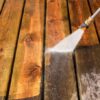There may not be a magic bullet to instantly remove years of mold, soot, dirt, and grime from your home’s exterior, but power washing can remove unappealing build-up to restore a neater look to stucco, aluminum, steel, wood. traditional. and brick. Pressure washing can be done every few years for general maintenance; it’s also a great way to prepare an exterior for painting.
However, the task requires some skill and strict adherence to these guidelines on how to pressure wash a home. Spraying too aggressively could damage the coating or paint, and in fact, pressure washing is not recommended for stucco hardboard, bottle board, and rock board, all of which could be easily damaged in the process. There’s bound to be a bit of physical work ahead of you, too – serious scrubbing is practically guaranteed if it’s been a long time since your last power wash. And not following all safety measures to the letter could result in personal injury (if your home has more than one story, you’d better hire a professional for the job).
Pressure washers use a high pressure water spray ideal for tough cleaning jobs on boats, sidewalks and decks, as well as in homes. Its power is measured in pounds per square inch (psi), the amount of pressure that liquid contents exert on the walls of your container. They are available in gas and electric models; the gas variety can generate higher psi and is recommended contact Wollongong high pressure cleaning services for tougher jobs and stronger materials. It’s portable too, so it’s better suited to hard-to-reach areas.
The psi required for building materials varies. Painted soft-grain wood siding, stucco, and aluminum siding are best treated with 1200 to 1500 psi models. For delicate stucco, it is also best to use a 25-30 degree wider spray nozzle to disperse the water over a wider area and with less force, avoiding any scratches or nicks. For sturdy unpainted materials such as brick, stone, vinyl, and steel, a machine rated at 2,500 to 3,000 psi is recommended.
Professionals charge between 10 and 80 cents per square foot, while gas and electric pressure washers can be rented from large home centers for around $ 100 a day. If you decide to DIY the job, talk to the rental agent and check the manual to make sure you’re choosing the right machine for the job. Ask the rental agent to demonstrate how to connect and disconnect the spray wand nozzles, then try it yourself to become familiar with it. Also, request a demonstration on how to attach the extension rod. Note: Bulky gear starts at around 75 pounds and can exceed 150 pounds, depending on the power and size of the model, so you may need a helper and truck to get it home.
The instructions below are for power washing a house with siding. Pick a mild day in spring or fall to tackle the project; preferably avoid the strong summer sun, which could dry out cleaning agents before you can rinse them off. With a combination of proper cleaning products, scrubbing, technique, and a good rinse, your home will be whistling clean once again.
How to pressure wash a house
Follow the steps below to power wash your home and remove accumulated dirt from the exterior of your home.
STEP 1
Protect shrubs, gardens, and lawns by covering them with protective cloth or plastic sheeting. Secure all sheets/cloths with tape.
STEP 2
Follow the directions on the package of your mildew detergent (available where you rent the machine or at home centers) to mix it with water in the five-gallon bucket. Add bleach in a volume of one part for every nine parts of the detergent-mildew solution. Pour this solution into the garden sprayer.
STEP 3
Set the pressure washer before scrubbing so it is ready to go. Locate the hose holder at the back of the pressure washer and connect the garden hose to this holder as well as to the hose faucet on the outside of the house. For harder surfaces and higher psi, use a 15 degree spray nozzle. For smoother surfaces and lower psi, choose a 25 or 30 degree nozzle. If you are doing a two story frame, you will want to make the top story first, so put in the extension rod. Also install the scaffold ahead of time, following the manufacturer’s instructions. Position it far enough from the wall so that it can stand in the center of the scaffold and have a reach of 1.5 to 3 feet, with the rod held comfortably in hand. Remember to lock the wheels in position before using the scaffold.
STAGE 4
Thoroughly spray a six to 10 foot section of a single story in your home with the mold solution. Starting from the bottom of the section and working your way up, gently but firmly scrub the siding with the soft siding brush. Working “up” is most effective because if you start from the top, the foam and liquid will run down the wall, potentially obscuring the sections enough to be missed. If you’re making a two-story house, start scrubbing on the top floor first, but clean from the “floor” of the scaffold to the top of the house.

Leave a Reply